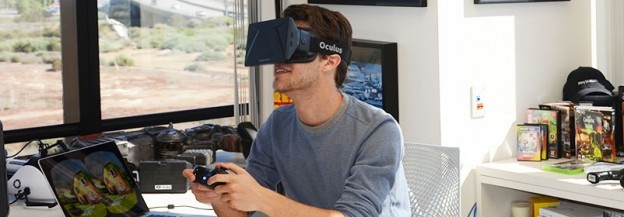Finally had some time with my Oculus Rift development kit over the last few weeks and I’ve been very impressed with the technology.
For those not in the know, the Oculus Rift is a Virtual Reality headset that tracks the player’s head movement while displaying 3D video games, pictures, or movies. It is extremely wild and definitely will mark the beginning of a VR resurgence.
Read on for more…
 So I’ve played a large number of games on the Rift so far. Both supported and unsupported games. Be warned that the experience is different depending on the game, person, and lens. Everyone has a different IPD (Interpupillary distance) which the Rift can be calibrated to, but every game essentially handles this kind of differently or almost inconsistantly. Not to mention, that there are different lenses for different types of eyesight like 20/20, near sighted, far sighted. Also, just like 3D in general, everyone has different sensitivity. One person might not be affected by 3D or motion sickness as much as the next guy who might topple over immediately.
So I’ve played a large number of games on the Rift so far. Both supported and unsupported games. Be warned that the experience is different depending on the game, person, and lens. Everyone has a different IPD (Interpupillary distance) which the Rift can be calibrated to, but every game essentially handles this kind of differently or almost inconsistantly. Not to mention, that there are different lenses for different types of eyesight like 20/20, near sighted, far sighted. Also, just like 3D in general, everyone has different sensitivity. One person might not be affected by 3D or motion sickness as much as the next guy who might topple over immediately.
Personally I find the Rift to be pretty comfortable for a little while, but after about an hour my pupils begin to feel strained. It takes getting used to that is for absolute certain. It doesn’t detract from the experience though, because a quick refresh taking off the goggles and putting them back on always helps.
 This is what the Rift sees. Essentially the Rift has one tiny 5.6 inch 1280×800 screen that gets 2 separate images – one for each eye (called side-by-side 3D). The lenses then magnify the images and your eyes perceive the image as one single image, which leads to 3D effects like you see in the movies. Couple this with some awesome accelerometers and you get headtracking, so where you look in the real world is where the game looks/aims.
This is what the Rift sees. Essentially the Rift has one tiny 5.6 inch 1280×800 screen that gets 2 separate images – one for each eye (called side-by-side 3D). The lenses then magnify the images and your eyes perceive the image as one single image, which leads to 3D effects like you see in the movies. Couple this with some awesome accelerometers and you get headtracking, so where you look in the real world is where the game looks/aims.
There are some downsides. Here the resolution of 1280×800 is far too small. Because the image is split in 2, your eyes only get 640×800 resolution. What does this mean? Blurry image quality and games. As well as an annoying “screen door” effect where you can see individual pixels. There is a solution: a new Oculus Rift with HD resolution is in development but its a question of when they will release it for developers if at all until they finish the product for market consumption. There is only other complaint I could possibly have here is that a wireless version would be absolutely fantastic, but its a minor gripe compared to the resolution issue.
That aside, the Rift is a lot of fun. It really brings Virtual Reality back to gaming in a VERY good way. It also means that there will be lots of new and interesting game ideas coming out from the woodwork. In fact, there already has! These games are super awesome. Dumpy has you control an elephant swinging your trunk around knocking things over, Alone is an atmospheric scare game where your perspective is toyed with eerily. There are others that couple the Rift with motion technology like Microsoft’s Kinect or Sony’s Move controllers, seen below.
There are just a ton of possibilities with this device. Valve, creators of Half Life and Portal, have already added native support to games like Half Life 2 and Team Fortress 2. There is so much customization options for players to choose their style of play (like where you look is where you aim or an out of body experience control point for example) that almost no one can be left out or feel uncomfortable with controls.
I personally can’t wait to come up with some awesome ideas to work on for this. I’ve spoiled some opportunities already, but I plan to make up for lost time eventually. There is huge potential here with the Oculus Rift, and I cannot wait to see how far this goes.
The Oculus Rift is available for $300 for developers, and the consumer version is still TBA.
P.S: Even Grandmas (90) love the Oculus Rift!


